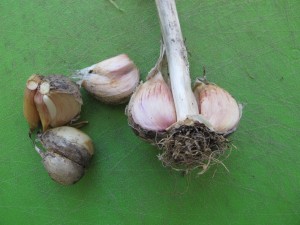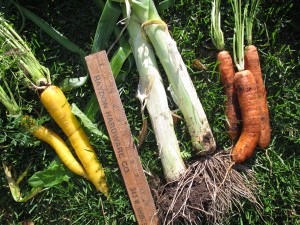Garlic and Carrots and Leeks, Oh My!
Some vegetables are as reliable as a sturdy shovel. Others – we all know – please us some years, disappoint us others. We grow tomatoes never knowing if the harvest will be bountiful or meager. But garlic and carrots and leeks, for me at least, are totally reliable. Year after year I know that I’ll harvest a good crop.
Now is the time to plant garlic. If you haven’t bought any garlic for planting, you’d better hustle to get some before your local farm stand closes for the season. It is, after all, officially fall. Avoid buying grocery store garlic as it is often treated with a chemical to keep it from sprouting – and is probably the wrong kind. But your local farm stand or farmers market should have garlic that will work just fine. Some garden centers will have seed garlic for sale, too.
A few words about types of garlic: there are two basic categories and many different varieties, each with a distinct flavor and “bite”. What we grow in New England is hard-neck garlic, which has a stiff woody stalk around which the individual cloves (sections) grow. Soft-neck garlic is generally from California, and is the kind that is braided and hung on restaurant walls – or found in grocery stores. Soft neck garlic is less hardy and may not overwinter.
I plant my garlic in mid-October. This allows the plants to establish roots, and then go dormant. If you plant in spring, you may find the garlic bolts and does not grow big cloves.
If you are using your own garlic that you harvested in August, pick your finest heads (or bulbs) to use for planting. In my experience, small heads will produce small heads next year. And for cooking, big heads are easier to work with.
Prepare a bed by digging in compost to enrich the soil and to provide good drainage. I create raised beds that are 30 inches wide and 6 inches above the walkways. I rake the bed smooth and create furrows 6 to 8 inches apart across the row. I then sprinkle organic fertilizer in the furrows and scratch it in. Next I separate the cloves and plant them about 4 inches apart and 2 inches deep. I cover the cloves and pat down the soil.
Finally I cover everything with a thick layer of straw or mulch hay. I spread the hay 8 to 12 inches deep (and fluffy), but by spring it has packed down and is more like 4 or 5 inches of cover. This mulch keeps most weeds at bay, but the garlic grows right through it.
Most of my carrots are still in the ground – they tolerate frost and cold, and get sweeter after a good chilling – some of the starches turn to sugars. I generally store carrots for winter in a spare fridge in the basement, but you can also store them in a bucket of damp sand in the garage, mudroom or bulkhead. Mice love carrots, so I recommend covering the bucket of carrots with quarter-inch wire mesh.
Another way to store carrots is to leave them in the ground. You can keep the ground from freezing by covering them with a thick layer of mulch hay that is then covered with a layer of leaves. I put a pole at each end of the row so that I can find it under a deep January snow. This method works fine, though I have suffered some rodent damage on occasion. If you find any chewed carrots now, harvest and store inside.
Leeks are another friend of mine that always produce well. I love leek and potato soup in the winter so I store most of mine, though I keep some for fresh use as a substitute for onion when my onions (fickle, some years) are less than bountiful. In my experience, leeks stored in the fridge or cold cellar lose their appeal quite quickly, so I freeze them. I clean and chop them up, then freeze in freezer-grade zipper bags. I do not blanch them.
Here is my version of leek and potato soup:
3 strips lean thick-cut bacon
2-3 cups chopped leeks
2 -3 cups diced potatoes
½ cup flour
2 chopped tomatoes
2 cups milk
1 handful chopped fresh parsley
1 bay leaf
¼ teaspoon nutmeg
½ teaspoon cinnamon
1 teaspoon Herbes de Provence
Lightly brown bacon in a heavy soup pot, then add leeks and potatoes, stirring constantly to brown. Add 4-6 cups water. In a dish stir water into the flour to get a thick but lump-free mixture. Add to soup pot and stir well. Add spices and tomatoes and simmer for half an hour. Just before serving add milk but do not boil the milk. You can make this vegetarian by avoiding the bacon and substituting butter or olive oil.
I have a vegetable garden, in part, because I love to cook. Eating my own vegetables give me great pleasure, particularly in winter – which is just around the corner.
Contact Henry by email at henry.homeyer@comcast.net or write him at PO box 364, Cornish Flat, NH 03746. Visit his Web site at www.Gardening-Guy.com.




